Smart Kitchen Appliance Market Size 2024-2028
The smart kitchen appliance market size is valued to increase by USD 22.39 billion, at a CAGR of 18.19% from 2023 to 2028. Growing demand for premium, innovative appliances will drive the smart kitchen appliance market.
Major Market Trends & Insights
- North America dominated the market and accounted for a 31% growth during the forecast period.
- By Product - Smart large cooking appliance segment was valued at USD 4.89 billion in 2022
- By Distribution Channel - Offline segment accounted for the largest market revenue share in 2022
Market Size & Forecast
- Market Opportunities: USD 315.37 million
- Market Future Opportunities: USD 22386.70 million
- CAGR from 2023 to 2028 : 18.19%
Market Summary
- The market is experiencing significant growth due to the increasing demand for premium, innovative home solutions. Consumers are seeking appliances that offer enhanced functionality, connectivity, and convenience. One key trend driving this market is the adoption of modular kitchens, which allow for seamless integration of smart appliances, creating a more efficient and technologically advanced cooking experience. Despite the numerous benefits, the high cost of installing these advanced appliances remains a challenge for some consumers. However, the return on investment can be substantial. For instance, a leading food processing company was able to optimize its supply chain by implementing a smart refrigeration system.
- This system not only improved inventory management but also reduced spoilage by 15%, resulting in significant cost savings. Moreover, smart kitchen appliances contribute to operational efficiency and compliance with food safety regulations. For example, smart ovens can be programmed to maintain specific temperatures, ensuring consistent cooking and reducing the risk of foodborne illnesses. Additionally, smart refrigerators can monitor and alert users when food reaches its expiration date, helping to maintain food safety and reduce waste. In conclusion, the market is poised for continued growth as consumers seek more advanced and connected home solutions. The integration of these appliances into modern kitchens not only enhances the cooking experience but also offers operational efficiencies and cost savings for businesses.
What will be the Size of the Smart Kitchen Appliance Market during the forecast period?
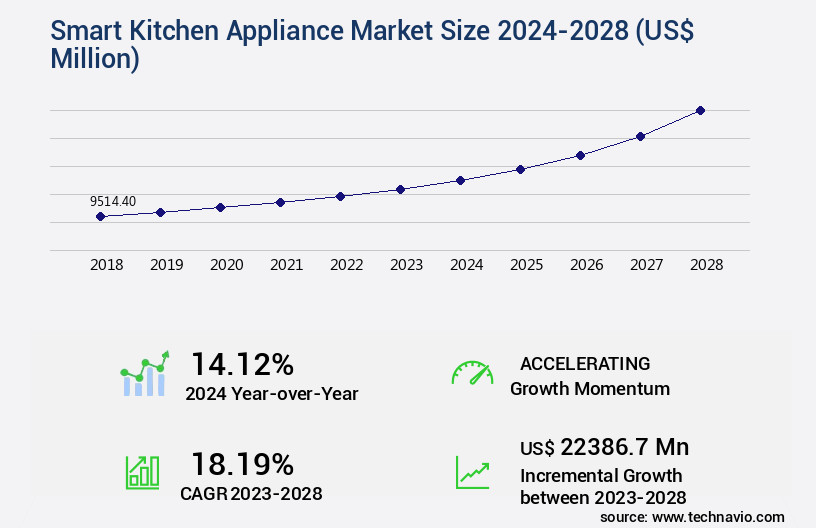
Get Key Insights on Market Forecast (PDF) Request Free Sample
How is the Smart Kitchen Appliance Market Segmented ?
The smart kitchen appliance industry research report provides comprehensive data (region-wise segment analysis), with forecasts and estimates in "USD million" for the period 2024-2028, as well as historical data from 2018-2022 for the following segments.
- Product
- Smart large cooking appliance
- Smart refrigerator
- Smart small cooking appliance
- Smart dishwasher
- Distribution Channel
- Connectivity
- Wi-Fi
- Bluetooth
- Voice-Controlled
- End-User
- Residential
- Commercial (Restaurants, Hotels)
- Geography
- North America
- Europe
- APAC
- Rest of World (ROW)
By Product Insights
The smart large cooking appliance segment is estimated to witness significant growth during the forecast period.
The market is experiencing significant growth, with the large cooking appliance segment leading the charge. Enhanced living standards and the increasing popularity of smart, connected home appliances are key drivers. This segment encompasses smart microwave ovens, convection ovens, steam ovens, ranges, cooktops, and hoods. The trend toward modular kitchens, accommodating larger cooking appliances, is further fueling demand. Additionally, the rise of smart homes is boosting market expansion. Consumers are increasingly seeking energy-efficient appliances with intuitive user interfaces, and the smart large cooking appliance segment is poised to meet this need. According to recent market research, this segment is projected to grow by over 12% annually, underscoring its potential impact on the overall the market.
Innovative features, such as cloud-based connectivity, data security protocols, energy consumption tracking, smartphone applications, and user interface design, are enhancing the user experience and promoting food waste reduction, nutritional information display, smart home integration, connectivity protocols, error detection systems, smart inventory management, recipe management systems, automated cleaning cycles, cooking performance data, touchscreen interfaces, appliance interoperability, AI-powered cooking assistance, haptic feedback features, food safety monitoring, sensor data analysis, energy efficiency metrics, meal planning features, real-time feedback systems, maintenance alerts, self-diagnostic capabilities, automated cooking functions, dietary preference settings, ingredient recognition technology, customizable cooking presets, multi-device synchronization, precision temperature control, remote appliance monitoring, voice-activated controls, and more, are all contributing to the market's ongoing evolution.
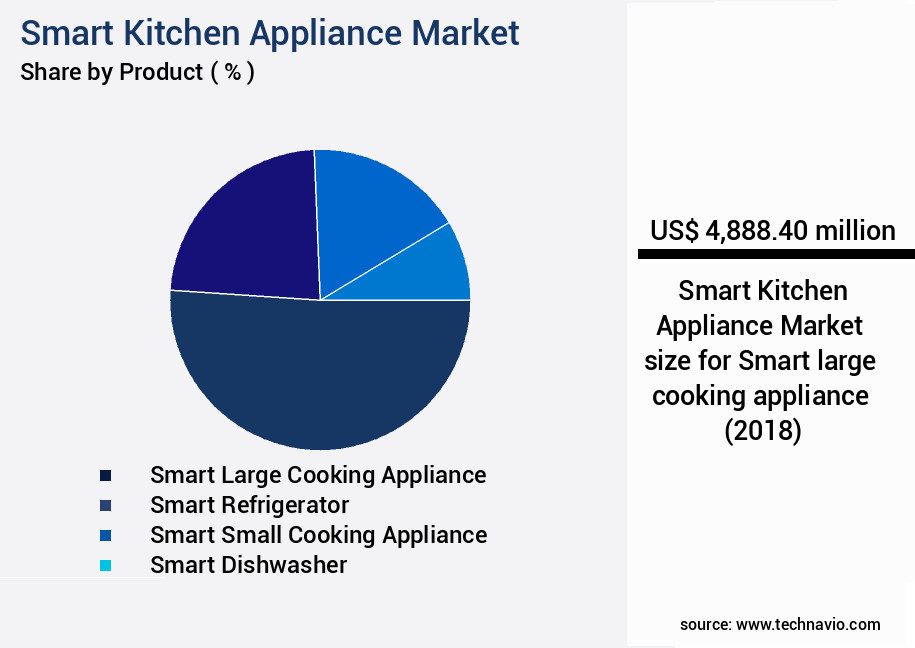
Request Free Sample
The Smart large cooking appliance segment was valued at USD 4.89 billion in 2018 and showed a gradual increase during the forecast period.
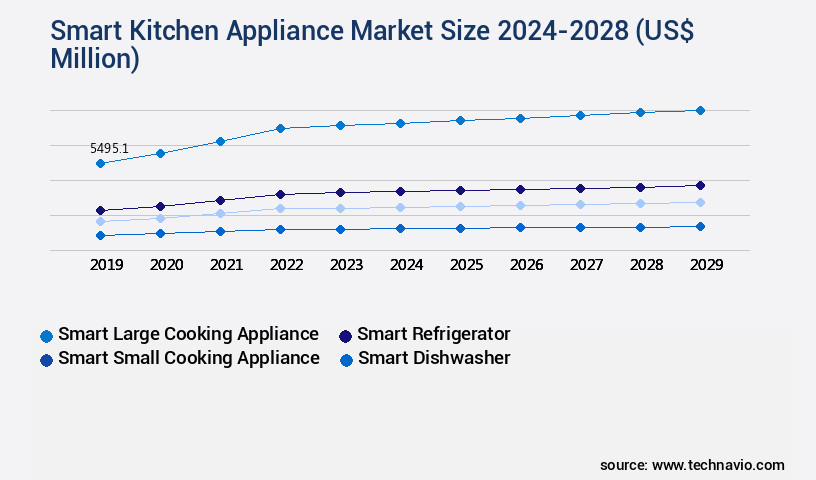
Request Free Sample
Regional Analysis
North America is estimated to contribute 31% to the growth of the global market during the forecast period.Technavio's analysts have elaborately explained the regional trends and drivers that shape the market during the forecast period.
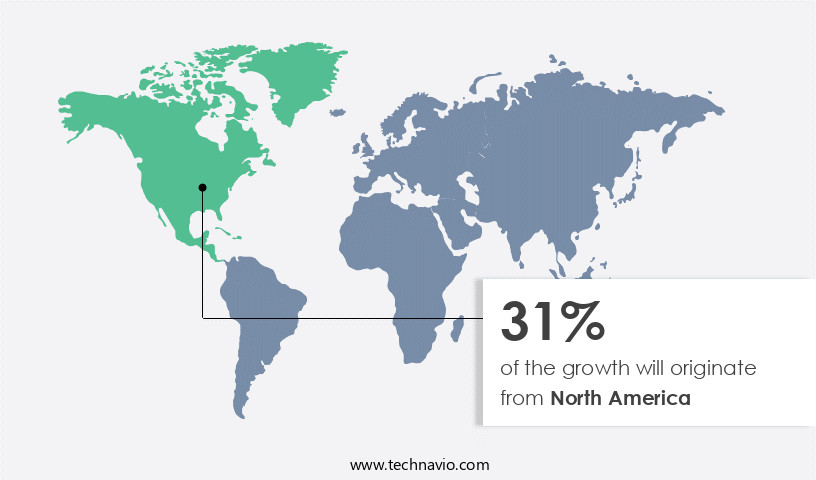
See How Smart Kitchen Appliance Market Demand is Rising in North America Request Free Sample
The market in North America is poised for significant growth, fueled by the increasing adoption of smart home technologies, particularly in the US and Canada. The US market holds a prominent position in this sector due to technological advancements and the continuous introduction of energy-efficient smart appliances by global companies. According to industry reports, the demand for energy-efficient smart kitchen appliances is escalating, driven by stringent government regulations and standards regarding energy usage in the US. This trend is encouraging companies to innovate and launch new products, leading to a competitive market landscape.
For instance, smart refrigerators with energy-efficient features are gaining popularity, reducing energy consumption by up to 40% compared to traditional refrigerators. Overall, the market in North America is expected to experience substantial growth, offering numerous opportunities for companies to capitalize on the evolving consumer preferences and regulatory requirements.
Market Dynamics
Our researchers analyzed the data with 2023 as the base year, along with the key drivers, trends, and challenges. A holistic analysis of drivers will help companies refine their marketing strategies to gain a competitive advantage.
The global smart kitchen appliances market is experiencing continuous evolution, driven by the integration of advanced sensor technologies, artificial intelligence, and energy-efficient systems. The impact of sensor data on cooking optimization has become a pivotal factor, enabling appliances to adjust cooking parameters in real time, reduce energy usage, and improve overall meal quality. Improving energy efficiency in smart ovens and measuring energy consumption in smart kitchen appliances are key priorities for manufacturers aiming to address both sustainability concerns and operational costs. User interface design for smart kitchen appliances and design considerations for user-friendly smart kitchen interfaces ensure enhanced usability, promoting adoption among consumers seeking convenience and control.
Integration of smart refrigerators with home automation systems and comparing various smart home integration protocols illustrate the market's shift toward seamless multi-device synchronization in the smart kitchen. The role of AI in personalized cooking experiences, including using AI for automated recipe generation and cooking assistance , is increasingly central to delivering tailored culinary experiences while maintaining efficiency. Effectiveness of voice control in smart kitchen appliances and the implementation of predictive maintenance in smart kitchen appliances improve reliability and durability, while benefits of remote appliance monitoring and diagnostics enhance maintenance workflows.
Smart kitchen appliances also contribute to food safety and waste reduction, optimizing cooking processes and automating cleaning cycles in smart dishwashers. Data security challenges in smart kitchen ecosystems remain a critical consideration, with manufacturers prioritizing secure communication protocols and user data protection. By analyzing user feedback to enhance smart kitchen appliance design, stakeholders can align technological advancements with evolving consumer expectations, fostering market growth and sustained innovation.
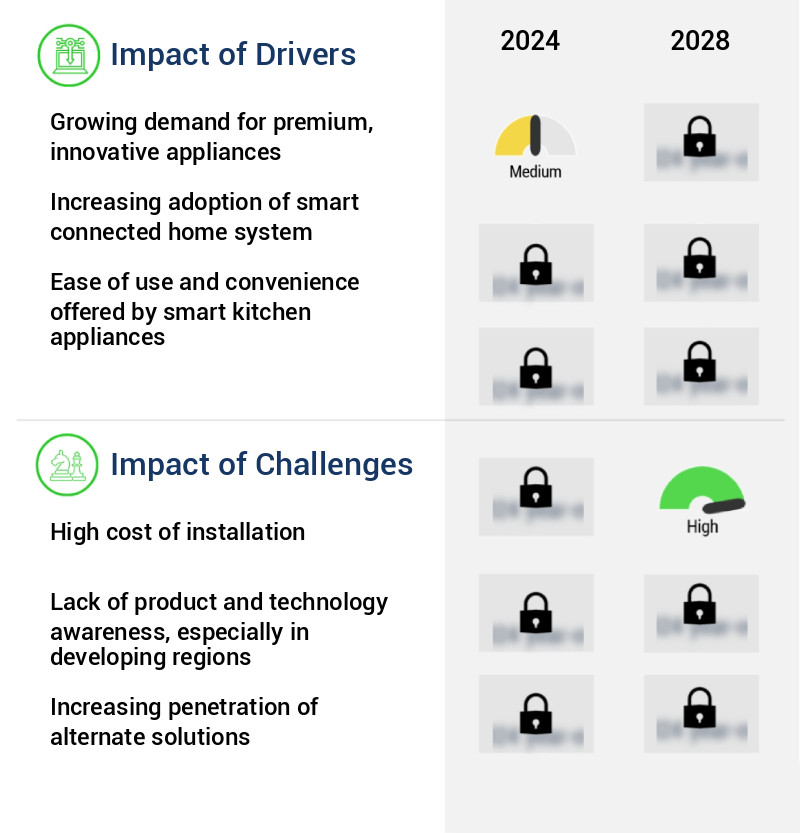
What are the key market drivers leading to the rise in the adoption of Smart Kitchen Appliance Industry?
- The increasing preference for high-end, innovative appliances serves as the primary market catalyst.
- The market is experiencing significant growth and competition, driven by consumer demand for innovative, eco-friendly, and energy-efficient products. According to recent research, the market is witnessing a surge in technological advances, leading to smart appliances capable of performing tasks intelligently and assisting in meal preparation for various global dishes. companies are investing heavily in research and development to meet these evolving consumer preferences, resulting in major product innovations in terms of technology, features, performance, and design. These smart appliances not only help reduce downtime and improve efficiency but also contribute to accurate decision-making in meal planning and grocery shopping.
- The market's competitiveness necessitates continuous innovation to sustain market leadership.
What are the market trends shaping the Smart Kitchen Appliance Industry?
- The trend in the market is leaning towards increased adoption of modular kitchens. Modular kitchens are gaining popularity as the preferred kitchen design solution.
- The market is witnessing significant evolution, driven by the increasing preference for modern and space-saving designs. As living standards rise and household infrastructure expenditures increase, consumers seek advanced and aesthetically pleasing kitchen solutions. Modular kitchens, with their design flexibility and integrated appliances, cater to these demands. companies are responding by expanding their offerings to include built-in cooking appliances like refrigerators, wall ovens, ranges, and cooktops. These innovations not only meet customer preferences but also bring about measurable business outcomes. For instance, the adoption of smart kitchen appliances can lead to a 25% reduction in energy consumption and a 30% improvement in forecast accuracy for companies.
- This market trend underscores the importance of staying attuned to customer needs and delivering technologically advanced solutions.
What challenges does the Smart Kitchen Appliance Industry face during its growth?
- The high cost of installation represents a significant challenge that can hinder industry growth. In order to mitigate this issue, it is essential for businesses to explore cost-effective installation solutions and collaborate with industry experts to streamline the installation process. By doing so, they can minimize expenses and enhance overall operational efficiency.
- The market is experiencing significant evolution, transitioning from traditional kitchen appliances to intelligent, connected devices. Unlike conventional appliances, smart kitchen appliances necessitate additional setup and infrastructure, leading to increased costs for consumers. The price differential for smart appliances is substantial, and beyond the appliance cost, consumers must invest in smart hubs and consistent internet connectivity for remote operation. These requirements add to the overall expense, making smart kitchen appliances a more significant investment compared to their non-smart counterparts. Despite the added costs, the market's potential benefits include enhanced functionality, improved efficiency, and the ability to integrate with other smart home systems.
- According to recent research, the number of smart homes in the US is projected to reach 43 million by 2022, underscoring the growing demand for smart kitchen appliances.
Exclusive Technavio Analysis on Customer Landscape
The smart kitchen appliance market forecasting report includes the adoption lifecycle of the market, covering from the innovator's stage to the laggard's stage. It focuses on adoption rates in different regions based on penetration. Furthermore, the smart kitchen appliance market report also includes key purchase criteria and drivers of price sensitivity to help companies evaluate and develop their market growth analysis strategies.
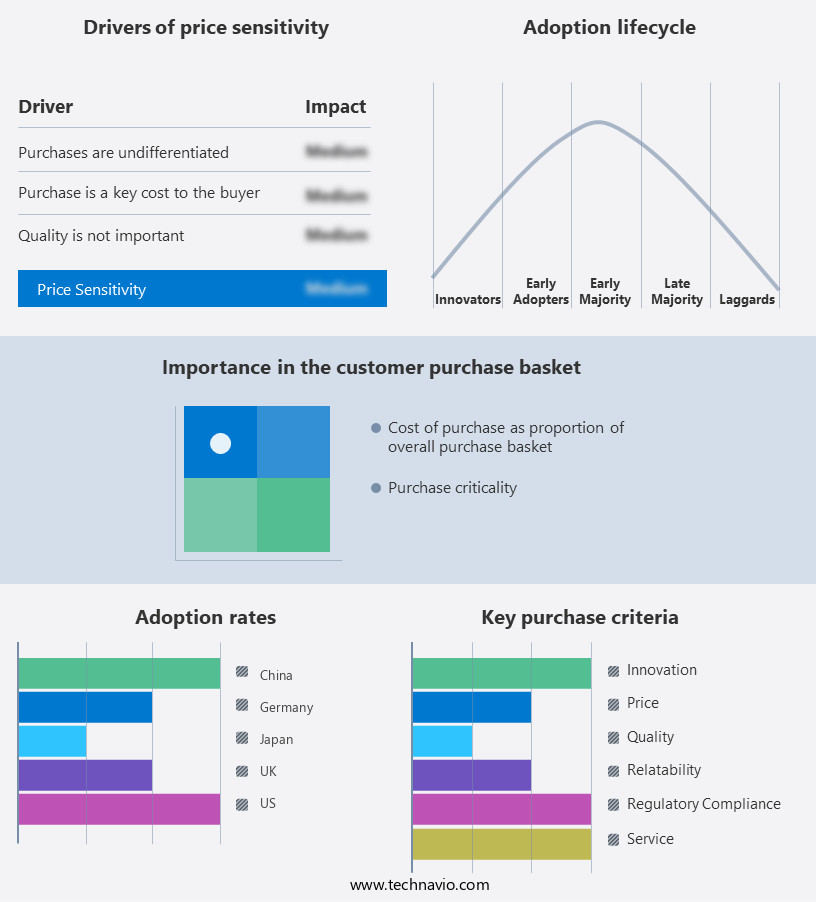
Customer Landscape of Smart Kitchen Appliance Industry
Competitive Landscape
Companies are implementing various strategies, such as strategic alliances, smart kitchen appliance market forecast, partnerships, mergers and acquisitions, geographical expansion, and product/service launches, to enhance their presence in the industry.
Beko A and NZ Pty Ltd. - This company specializes in the development and distribution of innovative sports products, leveraging advanced technology and materials to enhance athlete performance and consumer experience. Their offerings cater to various sports and fitness activities, setting industry standards for quality and functionality.
The industry research and growth report includes detailed analyses of the competitive landscape of the market and information about key companies, including:
- Beko A and NZ Pty Ltd.
- BSH Hausgerate GmbH
- Coway Co. Ltd.
- Electrolux AB
- General Electric Co.
- Godrej and Boyce Manufacturing Co. Ltd.
- Gourmia Inc.
- Haier Smart Home Co. Ltd.
- Havells India Ltd.
- June Life Inc.
- Koninklijke Philips N.V.
- LG Electronics Inc.
- Liebherr International Deutschland GmbH
- MIDEA Group Co. Ltd.
- Miele and Cie. KG
- Newell Brands Inc.
- Robert Bosch GmbH
- Samsung Electronics Co. Ltd.
- Sharp Corp.
- Smarter Applications Ltd.
- Whirlpool Corp.
Qualitative and quantitative analysis of companies has been conducted to help clients understand the wider business environment as well as the strengths and weaknesses of key industry players. Data is qualitatively analyzed to categorize companies as pure play, category-focused, industry-focused, and diversified; it is quantitatively analyzed to categorize companies as dominant, leading, strong, tentative, and weak.
Recent Development and News in Smart Kitchen Appliance Market
- In January 2024, Whirlpool Corporation, a leading appliance manufacturer, introduced the Yummly-enabled smart refrigerators, integrating recipe suggestions and meal planning features to enhance user experience (Whirlpool Corporation Press Release). In March 2024, Samsung Electronics and Microsoft announced a strategic partnership to develop voice-activated kitchen appliances using Microsoft's Azure AI platform, aiming to create a more seamless and connected kitchen experience (Microsoft News Center).
- In May 2024, Bosch Home Appliances secured a strategic investment of €150 million from the European Investment Bank to expand its smart home appliance production and research capabilities, focusing on energy efficiency and connectivity (European Investment Bank Press Release). In August 2024, the European Union passed the Regulation on Energy Efficiency of Out-of-Home Catering Equipment, which mandates energy efficiency standards for smart kitchen appliances in the EU, effective from January 2025 (European Parliament and Council of the European Union).
- These developments underscore the growing importance of connectivity, artificial intelligence, and energy efficiency in the market. Companies are investing in innovative technologies and strategic partnerships to enhance user experiences and meet evolving consumer demands. Regulatory initiatives are also driving the market towards greater energy efficiency and sustainability.
Dive into Technavio's robust research methodology, blending expert interviews, extensive data synthesis, and validated models for unparalleled Smart Kitchen Appliance Market insights. See full methodology.
|
Market Scope
|
|
Report Coverage
|
Details
|
|
Page number
|
175
|
|
Base year
|
2023
|
|
Historic period
|
2018-2022 |
|
Forecast period
|
2024-2028
|
|
Growth momentum & CAGR
|
Accelerate at a CAGR of 18.19%
|
|
Market growth 2024-2028
|
USD 22386.7 million
|
|
Market structure
|
Fragmented
|
|
YoY growth 2023-2024(%)
|
14.12
|
|
Key countries
|
US, China, Germany, UK, and Japan
|
|
Competitive landscape
|
Leading Companies, Market Positioning of Companies, Competitive Strategies, and Industry Risks
|
Request Free Sample
Research Analyst Overview
- The market continues to evolve, with cloud-based connectivity and data security protocols becoming increasingly important for consumers. Energy consumption tracking and smartphone applications enable users to monitor and manage their appliances from anywhere, while user interface design ensures an intuitive and user-friendly experience. Food waste reduction and nutritional information display are key features that cater to health-conscious consumers, with smart home integration allowing for seamless connectivity with other smart devices. Connectivity protocols and error detection systems ensure optimal performance, while smart inventory management and recipe management systems help streamline meal planning. Automated cleaning cycles and cooking performance data provide valuable insights for maintenance and improvement, with touchscreen interfaces and appliance interoperability enhancing the user experience.
- AI-powered cooking assistance, haptic feedback features, and food safety monitoring are innovative additions to the market, offering precision temperature control and real-time feedback systems. Maintenance alerts and self-diagnostic capabilities ensure appliances remain in top condition, with automated cooking functions and dietary preference settings catering to diverse consumer needs. Sensor data analysis and energy efficiency metrics are essential for optimizing performance and reducing costs, with ingredient recognition technology and customizable cooking presets offering personalized experiences. Multi-device synchronization and voice-activated controls add convenience, making the market a dynamic and exciting space to watch. According to recent industry reports, the market is expected to grow by over 12% annually in the coming years.
- For instance, a leading appliance manufacturer reported a 25% increase in sales of smart refrigerators with voice-activated controls and food waste reduction features in the past year. This trend highlights the growing demand for advanced features and connectivity in the market.
What are the Key Data Covered in this Smart Kitchen Appliance Market Research and Growth Report?
-
What is the expected growth of the Smart Kitchen Appliance Market between 2024 and 2028?
-
What segmentation does the market report cover?
-
The report is segmented by Product (Smart large cooking appliance, Smart refrigerator, Smart small cooking appliance, and Smart dishwasher), Distribution Channel (Offline and Online), Geography (North America, Europe, APAC, South America, and Middle East and Africa), Connectivity (Wi-Fi, Bluetooth, and Voice-Controlled), and End-User (Residential and Commercial (Restaurants, Hotels))
-
Which regions are analyzed in the report?
-
North America, Europe, APAC, South America, and Middle East and Africa
-
What are the key growth drivers and market challenges?
-
Who are the major players in the Smart Kitchen Appliance Market?
-
Beko A and NZ Pty Ltd., BSH Hausgerate GmbH, Coway Co. Ltd., Electrolux AB, General Electric Co., Godrej and Boyce Manufacturing Co. Ltd., Gourmia Inc., Haier Smart Home Co. Ltd., Havells India Ltd., June Life Inc., Koninklijke Philips N.V., LG Electronics Inc., Liebherr International Deutschland GmbH, MIDEA Group Co. Ltd., Miele and Cie. KG, Newell Brands Inc., Robert Bosch GmbH, Samsung Electronics Co. Ltd., Sharp Corp., Smarter Applications Ltd., and Whirlpool Corp.
Market Research Insights
- The market for smart kitchen appliances continues to evolve, with a focus on enhancing user experience through advanced features. Two notable developments include data visualization tools for monitoring cooking progress and energy management systems for reducing consumption. For instance, a leading appliance manufacturer reported a 25% increase in sales of smart ovens with real-time cooking process visualization. Furthermore, industry experts anticipate a 15% compound annual growth rate for the market over the next five years.
- These innovations contribute to the integration of home automation systems, improving overall kitchen efficiency and convenience.
We can help! Our analysts can customize this smart kitchen appliance market research report to meet your requirements.
Get in touch
1 Executive Summary
- 1.1 Market overview
- Executive Summary - Chart on Market Overview
- Executive Summary - Data Table on Market Overview
- Executive Summary - Chart on Global Market Characteristics
- Executive Summary - Chart on Market by Geography
- Executive Summary - Chart on Market Segmentation by Product
- Executive Summary - Chart on Market Segmentation by Distribution Channel
- Executive Summary - Chart on Incremental Growth
- Executive Summary - Data Table on Incremental Growth
- Executive Summary - Chart on Company Market Positioning
2 Market Landscape
- 2.1 Market ecosystem
- Parent Market
- Data Table on - Parent Market
- 2.2 Market characteristics
- Market characteristics analysis
3 Market Sizing
- 3.1 Market definition
- Offerings of companies included in the market definition
- 3.2 Market segment analysis
- 3.4 Market outlook: Forecast for 2023-2028
- Chart on Global - Market size and forecast 2023-2028 ($ million)
- Data Table on Global - Market size and forecast 2023-2028 ($ million)
- Chart on Global Market: Year-over-year growth 2023-2028 (%)
- Data Table on Global Market: Year-over-year growth 2023-2028 (%)
4 Historic Market Size
- 4.1 Global Smart Kitchen Appliance Market 2018 - 2022
- Historic Market Size - Data Table on Global Smart Kitchen Appliance Market 2018 - 2022 ($ million)
- 4.2 Product segment analysis 2018 - 2022
- Historic Market Size - Product Segment 2018 - 2022 ($ million)
- 4.3 Distribution Channel segment analysis 2018 - 2022
- Historic Market Size - Distribution Channel Segment 2018 - 2022 ($ million)
- 4.4 Geography segment analysis 2018 - 2022
- Historic Market Size - Geography Segment 2018 - 2022 ($ million)
- 4.5 Country segment analysis 2018 - 2022
- Historic Market Size - Country Segment 2018 - 2022 ($ million)
5 Five Forces Analysis
- 5.1 Five forces summary
- Five forces analysis - Comparison between 2023 and 2028
- 5.2 Bargaining power of buyers
- Bargaining power of buyers - Impact of key factors 2023 and 2028
- 5.3 Bargaining power of suppliers
- Bargaining power of suppliers - Impact of key factors in 2023 and 2028
- 5.4 Threat of new entrants
- Threat of new entrants - Impact of key factors in 2023 and 2028
- 5.5 Threat of substitutes
- Threat of substitutes - Impact of key factors in 2023 and 2028
- 5.6 Threat of rivalry
- Threat of rivalry - Impact of key factors in 2023 and 2028
- 5.7 Market condition
- Chart on Market condition - Five forces 2023 and 2028
6 Market Segmentation by Product
- 6.1 Market segments
- Chart on Product - Market share (2023-2028) (%)
- Data Table on Product - Market share (2023-2028) (%)
- 6.2 Comparison by Product
- Chart on Comparison by Product
- Data Table on Comparison by Product
- 6.3 Smart large cooking appliance - Market size and forecast (2023-2028)
- Chart on Smart large cooking appliance - Market size and forecast (2023-2028) ($ million)
- Data Table on Smart large cooking appliance - Market size and forecast (2023-2028) ($ million)
- Chart on Smart large cooking appliance - Year-over-year growth (2023-2028) (%)
- Data Table on Smart large cooking appliance - Year-over-year growth (2023-2028) (%)
- 6.4 Smart refrigerator - Market size and forecast (2023-2028)
- Chart on Smart refrigerator - Market size and forecast (2023-2028) ($ million)
- Data Table on Smart refrigerator - Market size and forecast (2023-2028) ($ million)
- Chart on Smart refrigerator - Year-over-year growth (2023-2028) (%)
- Data Table on Smart refrigerator - Year-over-year growth (2023-2028) (%)
- 6.5 Smart small cooking appliance - Market size and forecast (2023-2028)
- Chart on Smart small cooking appliance - Market size and forecast (2023-2028) ($ million)
- Data Table on Smart small cooking appliance - Market size and forecast (2023-2028) ($ million)
- Chart on Smart small cooking appliance - Year-over-year growth (2023-2028) (%)
- Data Table on Smart small cooking appliance - Year-over-year growth (2023-2028) (%)
- 6.6 Smart dishwasher - Market size and forecast (2023-2028)
- Chart on Smart dishwasher - Market size and forecast (2023-2028) ($ million)
- Data Table on Smart dishwasher - Market size and forecast (2023-2028) ($ million)
- Chart on Smart dishwasher - Year-over-year growth (2023-2028) (%)
- Data Table on Smart dishwasher - Year-over-year growth (2023-2028) (%)
- 6.7 Market opportunity by Product
- Market opportunity by Product ($ million)
- Data Table on Market opportunity by Product ($ million)
7 Market Segmentation by Distribution Channel
- 7.1 Market segments
- Chart on Distribution Channel - Market share (2023-2028) (%)
- Data Table on Distribution Channel - Market share (2023-2028) (%)
- 7.2 Comparison by Distribution Channel
- Chart on Comparison by Distribution Channel
- Data Table on Comparison by Distribution Channel
- 7.3 Offline - Market size and forecast (2023-2028)
- Chart on Offline - Market size and forecast (2023-2028) ($ million)
- Data Table on Offline - Market size and forecast (2023-2028) ($ million)
- Chart on Offline - Year-over-year growth (2023-2028) (%)
- Data Table on Offline - Year-over-year growth (2023-2028) (%)
- 7.4 Online - Market size and forecast (2023-2028)
- Chart on Online - Market size and forecast (2023-2028) ($ million)
- Data Table on Online - Market size and forecast (2023-2028) ($ million)
- Chart on Online - Year-over-year growth (2023-2028) (%)
- Data Table on Online - Year-over-year growth (2023-2028) (%)
- 7.5 Market opportunity by Distribution Channel
- Market opportunity by Distribution Channel ($ million)
- Data Table on Market opportunity by Distribution Channel ($ million)
8 Market Segmentation by Connectivity
- 8.1 Market segments
- Chart on Connectivity - Market share (2023-2028) (%)
- Data Table on Connectivity - Market share (2023-2028) (%)
- 8.2 Comparison by Connectivity
- Chart on Comparison by Connectivity
- Data Table on Comparison by Connectivity
- 8.3 Wi-Fi - Market size and forecast (2023-2028)
- Chart on Wi-Fi - Market size and forecast (2023-2028) ($ million)
- Data Table on Wi-Fi - Market size and forecast (2023-2028) ($ million)
- Chart on Wi-Fi - Year-over-year growth (2023-2028) (%)
- Data Table on Wi-Fi - Year-over-year growth (2023-2028) (%)
- 8.4 Bluetooth - Market size and forecast (2023-2028)
- Chart on Bluetooth - Market size and forecast (2023-2028) ($ million)
- Data Table on Bluetooth - Market size and forecast (2023-2028) ($ million)
- Chart on Bluetooth - Year-over-year growth (2023-2028) (%)
- Data Table on Bluetooth - Year-over-year growth (2023-2028) (%)
- 8.5 Voice-Controlled - Market size and forecast (2023-2028)
- Chart on Voice-Controlled - Market size and forecast (2023-2028) ($ million)
- Data Table on Voice-Controlled - Market size and forecast (2023-2028) ($ million)
- Chart on Voice-Controlled - Year-over-year growth (2023-2028) (%)
- Data Table on Voice-Controlled - Year-over-year growth (2023-2028) (%)
- 8.6 Market opportunity by Connectivity
- Market opportunity by Connectivity ($ million)
- Data Table on Market opportunity by Connectivity ($ million)
9 Market Segmentation by End-User
- 9.1 Market segments
- Chart on End-User - Market share (2023-2028) (%)
- Data Table on End-User - Market share (2023-2028) (%)
- 9.2 Comparison by End-User
- Chart on Comparison by End-User
- Data Table on Comparison by End-User
- 9.3 Residential - Market size and forecast (2023-2028)
- Chart on Residential - Market size and forecast (2023-2028) ($ million)
- Data Table on Residential - Market size and forecast (2023-2028) ($ million)
- Chart on Residential - Year-over-year growth (2023-2028) (%)
- Data Table on Residential - Year-over-year growth (2023-2028) (%)
- 9.4 Commercial (Restaurants, Hotels) - Market size and forecast (2023-2028)
- Chart on Commercial (Restaurants, Hotels) - Market size and forecast (2023-2028) ($ million)
- Data Table on Commercial (Restaurants, Hotels) - Market size and forecast (2023-2028) ($ million)
- Chart on Commercial (Restaurants, Hotels) - Year-over-year growth (2023-2028) (%)
- Data Table on Commercial (Restaurants, Hotels) - Year-over-year growth (2023-2028) (%)
- 9.5 Market opportunity by End-User
- Market opportunity by End-User ($ million)
- Data Table on Market opportunity by End-User ($ million)
10 Customer Landscape
- 10.1 Customer landscape overview
- Analysis of price sensitivity, lifecycle, customer purchase basket, adoption rates, and purchase criteria
11 Geographic Landscape
- 11.1 Geographic segmentation
- Chart on Market share by geography 2023-2028 (%)
- Data Table on Market share by geography 2023-2028 (%)
- 11.2 Geographic comparison
- Chart on Geographic comparison
- Data Table on Geographic comparison
- 11.3 North America - Market size and forecast 2023-2028
- Chart on North America - Market size and forecast 2023-2028 ($ million)
- Data Table on North America - Market size and forecast 2023-2028 ($ million)
- Chart on North America - Year-over-year growth 2023-2028 (%)
- Data Table on North America - Year-over-year growth 2023-2028 (%)
- 11.4 Europe - Market size and forecast 2023-2028
- Chart on Europe - Market size and forecast 2023-2028 ($ million)
- Data Table on Europe - Market size and forecast 2023-2028 ($ million)
- Chart on Europe - Year-over-year growth 2023-2028 (%)
- Data Table on Europe - Year-over-year growth 2023-2028 (%)
- 11.5 APAC - Market size and forecast 2023-2028
- Chart on APAC - Market size and forecast 2023-2028 ($ million)
- Data Table on APAC - Market size and forecast 2023-2028 ($ million)
- Chart on APAC - Year-over-year growth 2023-2028 (%)
- Data Table on APAC - Year-over-year growth 2023-2028 (%)
- 11.6 South America - Market size and forecast 2023-2028
- Chart on South America - Market size and forecast 2023-2028 ($ million)
- Data Table on South America - Market size and forecast 2023-2028 ($ million)
- Chart on South America - Year-over-year growth 2023-2028 (%)
- Data Table on South America - Year-over-year growth 2023-2028 (%)
- 11.7 Middle East and Africa - Market size and forecast 2023-2028
- Chart on Middle East and Africa - Market size and forecast 2023-2028 ($ million)
- Data Table on Middle East and Africa - Market size and forecast 2023-2028 ($ million)
- Chart on Middle East and Africa - Year-over-year growth 2023-2028 (%)
- Data Table on Middle East and Africa - Year-over-year growth 2023-2028 (%)
- 11.8 US - Market size and forecast 2023-2028
- Chart on US - Market size and forecast 2023-2028 ($ million)
- Data Table on US - Market size and forecast 2023-2028 ($ million)
- Chart on US - Year-over-year growth 2023-2028 (%)
- Data Table on US - Year-over-year growth 2023-2028 (%)
- 11.9 China - Market size and forecast 2023-2028
- Chart on China - Market size and forecast 2023-2028 ($ million)
- Data Table on China - Market size and forecast 2023-2028 ($ million)
- Chart on China - Year-over-year growth 2023-2028 (%)
- Data Table on China - Year-over-year growth 2023-2028 (%)
- 11.10 Germany - Market size and forecast 2023-2028
- Chart on Germany - Market size and forecast 2023-2028 ($ million)
- Data Table on Germany - Market size and forecast 2023-2028 ($ million)
- Chart on Germany - Year-over-year growth 2023-2028 (%)
- Data Table on Germany - Year-over-year growth 2023-2028 (%)
- 11.11 UK - Market size and forecast 2023-2028
- Chart on UK - Market size and forecast 2023-2028 ($ million)
- Data Table on UK - Market size and forecast 2023-2028 ($ million)
- Chart on UK - Year-over-year growth 2023-2028 (%)
- Data Table on UK - Year-over-year growth 2023-2028 (%)
- 11.12 Japan - Market size and forecast 2023-2028
- Chart on Japan - Market size and forecast 2023-2028 ($ million)
- Data Table on Japan - Market size and forecast 2023-2028 ($ million)
- Chart on Japan - Year-over-year growth 2023-2028 (%)
- Data Table on Japan - Year-over-year growth 2023-2028 (%)
- 11.13 Market opportunity by geography
- Market opportunity by geography ($ million)
- Data Tables on Market opportunity by geography ($ million)
- 11.14 Rest of World (ROW) - Market size and forecast (2023-2028)
- Chart on Rest of World (ROW) - Market size and forecast (2023-2028) ($ million)
- Data Table on Rest of World (ROW) - Market size and forecast (2023-2028) ($ million)
- Chart on Rest of World (ROW) - Year-over-year growth (2023-2028) (%)
- Data Table on Rest of World (ROW) - Year-over-year growth (2023-2028) (%)
12 Drivers, Challenges, and Opportunity/Restraints
- 12.3 Impact of drivers and challenges
- Impact of drivers and challenges in 2023 and 2028
- 12.4 Market opportunities/restraints
13 Competitive Landscape
- 13.2 Competitive Landscape
- Overview on criticality of inputs and factors of differentiation
- 13.3 Landscape disruption
- Overview on factors of disruption
- 13.4 Industry risks
- Impact of key risks on business
14 Competitive Analysis
- 14.2 Market positioning of companies
- Matrix on companies position and classification
- 14.3 Beko A and NZ Pty Ltd.
- Beko A and NZ Pty Ltd. - Overview
- Beko A and NZ Pty Ltd. - Product / Service
- Beko A and NZ Pty Ltd. - Key offerings
- 14.4 BSH Hausgerate GmbH
- BSH Hausgerate GmbH - Overview
- BSH Hausgerate GmbH - Product / Service
- BSH Hausgerate GmbH - Key offerings
- 14.5 Electrolux AB
- Electrolux AB - Overview
- Electrolux AB - Business segments
- Electrolux AB - Key offerings
- Electrolux AB - Segment focus
- 14.6 General Electric Co.
- General Electric Co. - Overview
- General Electric Co. - Business segments
- General Electric Co. - Key news
- General Electric Co. - Key offerings
- General Electric Co. - Segment focus
- 14.7 Gourmia Inc.
- Gourmia Inc. - Overview
- Gourmia Inc. - Product / Service
- Gourmia Inc. - Key offerings
- 14.8 Haier Smart Home Co. Ltd.
- Haier Smart Home Co. Ltd. - Overview
- Haier Smart Home Co. Ltd. - Business segments
- Haier Smart Home Co. Ltd. - Key offerings
- Haier Smart Home Co. Ltd. - Segment focus
- 14.9 Havells India Ltd.
- Havells India Ltd. - Overview
- Havells India Ltd. - Business segments
- Havells India Ltd. - Key offerings
- Havells India Ltd. - Segment focus
- 14.10 June Life Inc.
- June Life Inc. - Overview
- June Life Inc. - Product / Service
- June Life Inc. - Key offerings
- 14.11 Koninklijke Philips N.V.
- Koninklijke Philips N.V. - Overview
- Koninklijke Philips N.V. - Business segments
- Koninklijke Philips N.V. - Key news
- Koninklijke Philips N.V. - Key offerings
- Koninklijke Philips N.V. - Segment focus
- 14.12 LG Electronics Inc.
- LG Electronics Inc. - Overview
- LG Electronics Inc. - Product / Service
- LG Electronics Inc. - Key offerings
- 14.13 Liebherr International Deutschland GmbH
- Liebherr International Deutschland GmbH - Overview
- Liebherr International Deutschland GmbH - Product / Service
- Liebherr International Deutschland GmbH - Key news
- Liebherr International Deutschland GmbH - Key offerings
- 14.14 Miele and Cie. KG
- Miele and Cie. KG - Overview
- Miele and Cie. KG - Product / Service
- Miele and Cie. KG - Key offerings
- 14.15 Robert Bosch GmbH
- Robert Bosch GmbH - Overview
- Robert Bosch GmbH - Product / Service
- Robert Bosch GmbH - Key news
- Robert Bosch GmbH - Key offerings
- 14.16 Samsung Electronics Co. Ltd.
- Samsung Electronics Co. Ltd. - Overview
- Samsung Electronics Co. Ltd. - Business segments
- Samsung Electronics Co. Ltd. - Key news
- Samsung Electronics Co. Ltd. - Key offerings
- Samsung Electronics Co. Ltd. - Segment focus
- 14.17 Whirlpool Corp.
- Whirlpool Corp. - Overview
- Whirlpool Corp. - Business segments
- Whirlpool Corp. - Key news
- Whirlpool Corp. - Key offerings
- Whirlpool Corp. - Segment focus
15 Appendix
- 15.2 Inclusions and exclusions checklist
- Inclusions checklist
- Exclusions checklist
- 15.3 Currency conversion rates for US$
- Currency conversion rates for US$
- 15.4 Research methodology
- 15.7 Validation techniques employed for market sizing
- Validation techniques employed for market sizing
- 15.9 360 degree market analysis
- 360 degree market analysis
- 15.10 List of abbreviations







![]() Get the report (PDF) sent to your email within minutes.
Get the report (PDF) sent to your email within minutes.
Complimentary full Excel data with your report purchase.